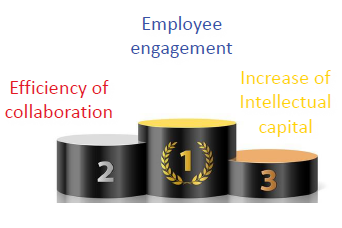The Virtuous Circle of Empowering Employees With A Digital Workplace

The “chicken and egg” question
We are continuously told to put the customer first. However, are we not missing a crucial element? Should the employee not be considered as equally important to the customer?
Remember what Richard Branson says: “Clients do not come first. Employees come first. If you take care of your employees, they will take care of the clients.“
Would it be incongruous to talk about happiness at the workplace? Happiness can indeed seem very personal and far from corporate responsibility. However, according to a study from the University of Warwick, happy professionals are up to 12% more productive than unhappy employees.
Psychology researcher Sonja Lyubomirsky describes happiness as the experience of positive well-being, combined with a sense that one’s life is meaningful. She suggests that happy people make better decisions. What would that specifically mean at the workplace?
Empower employees
Part of being happy is feeling in control, so empowerment is vital. When employees are emancipated in their jobs, they can deliver the extra mile. Social sciences have demonstrated that empowerment can be explored both at individual and organizational levels. Companies cannot escape their responsibility in that area.
The Thomas and Velthouse model of employee motivation shows that empowerment incorporates four facets:
- Meaningful tasks to accomplish
- Feeling of competence
- Work self-determination
- Personal impact over results
HR and IT must therefore work together in order to create an environment that enables employees to feel as such. HR must promote values such as trust and the freedom to act. And IT must deploy an applicative framework that fosters employees’ autonomy and self-training.
Empowering employees means giving people both the spirit and the tools to solve problems and complete their tasks with minimal manager’s intervention. Organizations have a duty to provide access to knowledge and expertise for staff to make informed decisions and act in efficient ways. Accessing the right information at the right time is an essential component of the employee empowerment.
Digital Workplace is pivotal
One of the objectives is to support data access and break data silos. The more distributed the data, the more challenging it is to find relevant insights.
According to McKinsey, employees spend close to two hours per day searching for information! An enterprise search application which connects people to corporate content is a key cog within Digital Workplace services. Such a tool has positive impacts on employees’ morale as people get meaningful information to make them successful in their responsibilities.
But accessing the right digital information is not enough as, from time to time, employees need to connect to peers or experts. Digital workplace is also about achieving a more human work environment contrary to the common belief that technology destroys relationships.
For instance, many of our customers have implemented a “Find the People” application which treats people as entities and offers the ability to discover the most knowledgeable people on particular subjects based on project reports, white papers, training materials, internal publications etc. And when the employee has identified a colleague with the right skills, he or she can contact this person. A “working” Digital Workplace has been proven to greatly increase one-to-one interactions.
And without being cynical, is the implementation of a Digital Workplace still an optional pursuit?
With the pandemic, companies’ ability to operate as a digital workplace has become essential. Covid-19 has triggered an involuntary trial for teleworking for most of us. Even people normally working in the same office have been separated during the lockdown. The Covid crisis has reshuffled digital transformation agendas for many organizations, and the post-Covid era will not reverse this trend!
What about the customers?
A study by the Work Institute states that the average cost of losing an employee is approximately at 33% of their annual wages. Training and retaining employees through an empowerment culture can save employers a lot of money. Securing a talented workforce plays a decisive role in the performance of any firm as the internal knowledge held by employees is a highly valuable asset.
No need to say that this is even more paramount for customer-facing staff. A single point of access to information through Digital Workplace gives the best chance to provide the right help to customers. In some context, data analytics can also anticipate what customers may require in the near future. Providing relevant information and the ability to solve problems are key success factors for a customer service.
To be effective in their roles, customer-facing employees should therefore be well-versed on company’s products and services in order to successfully respond to clients’ questions.
If an employee does not find the response on how to address a customer’s concern, he or she should find someone else who can assist – hence the “Find the People” capability mentioned before. And guess what? Employees able to satisfy customer requests can reduce their own stress levels and enhance their well-being. Happy employees make happy customers. And vice versa!

Employee engagement is now considered a top priority by business leaders
A recent survey related to Digital Workplace, sponsored by Sinequa and conducted by the independent organization Drive Innovation Insights (DII), shows the importance of empowering employees.
When assessing digital workplace needs, three metrics stand out as being particularly critical: Employee engagement, Efficiency of collaboration and Increase of intellectual capital. Digital workplace’s spectrum goes beyond efficiency at work. It is above all an essential driving force for the engagement and motivation of employees. Employee engagement is overall rated as the highest quality criteria by C-Level professionals involved in Digital Workplace programs.

It is now clear to executives that engaged employees take positive actions to exceed customers’ expectations. Happy employees definitely make happy customers and further improve a company’s performance!






